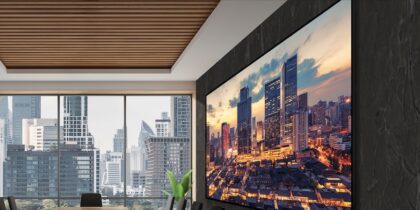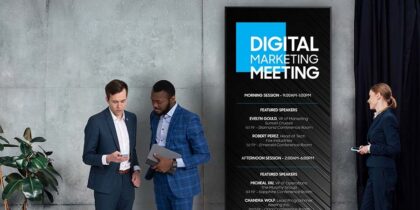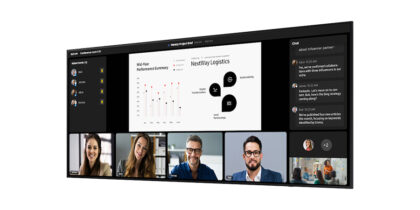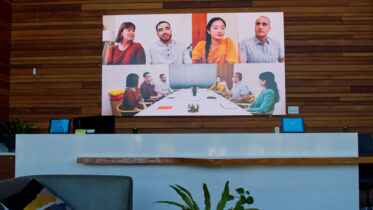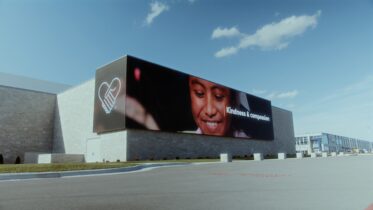Many tools enable people to be more productive in their own bubbles, but when it comes to sharing ideas and brainstorming solutions, workers need technology that brings them closer together.
That sort of work used to be done with whiteboards and paper flipcharts. But a new type of collaboration technology — introduced by Samsung in early 2018 and now in its second generation — took the best of those tools and made something different that was squarely focused on modern office dynamics.
The Samsung Flip 2 borrows on the form and function of those standing paper flipcharts you’ll recognize from countless meeting rooms, and makes it digital. It also simplifies and streamlines the kind of functionality users know from wall-mounted interactive whiteboards.
The Flip has garnered enthusiasm in environments from Fortune 500 meeting rooms to school classrooms. Based on customer feedback and real-world experience, the Flip 2 has a series of software and hardware enhancements, and expands the lineup to a pair of display sizes tuned to different working scenarios.
Tuned to the times
Samsung developed the Flip based on three years of interviews and behavioral studies, involving approximately 700 people working in different industries and circumstances around the world.
The ultimate guide to conference room technology
Download this guide to effectively planning your next meeting room technology upgrade. Download Now
About 95 percent of respondents said small, in-person meetings were what they liked and wanted most, and three-fourths said they wanted simple, familiar tools that presented little or no learning curve. Respondents also said they liked to bring their own devices to meetings, and wanted the ideas, conclusions and plans that came out of those meetings easily captured, archived and shared.
The research revealed a gap in the market between high-tech tools like digital whiteboards and remote meeting systems on the one hand, and old-school flipcharts and whiteboards on the other. People wanted technology that bridged the gap, addressed the pain points and made face-to-face meetings better.
A highly able flipchart
The Flip 2, like the original, takes on the shape and core function of a flipchart, and adds an immense amount of capability.
It’s a smart digital display that can do all of a working group’s list-making, chart-drawing and numbers-tallying on a centralized surface. It captures all the notes and doodles without anyone having to tear off sheets for transcription, take a photo or type notes back at a desk.
The Flip 2 offers a range of capabilities for workplaces. It’s:
- Portable: Just like paper flipcharts on easels, the Flip 2 has a stand and wheels, making it easy to move around offices or meeting room spaces.
- Simple: Walk up to a Flip 2 and it automatically turns on, identifying someone’s presence with an embedded smart sensor to help attendees dive right into meeting content.
- Flexible: Flip 2’s display works in traditional flipchart orientation, or can be pivoted to sit in landscape mode when the ideas and illustrations in a meeting need a wider format. It also tilts to allow for more natural writing.
- Synchronizable: Flip 2 has embedded computing power and is web-connected, making fully synchronized collaboration possible in meetings. People who bring a laptop, tablet or smartphone can mirror their screens to share content with the group.
- Presentable: Flip 2 can drive digital presentations. You can walk your team through a presentation deck, then pivot Flip into portrait mode to develop notes and gather real-time feedback.
- Searchable: Meeting notes all get captured and housed in a central database. Digging up what came out of last week’s product road map meeting is just a keyword search away.
- Shareable: Notes from a meeting can be recapped and shared straight from a Flip 2, using built-in email, network distribution or USB storage.
Refining enhancements
Here’s what’s new with the Flip 2:
- The original 55-inch version has been updated, and is now complemented by a larger 65-inch version intended as a wall-mounted whiteboard.
- Annotation takes only one tap on any source material shown on the display, without affecting the original work.
- Image editing is easy and flexible, and working in pen mode has more options, such as a brush mode for watercolor and oil painting.
- A built-in browser lets users directly access websites from the display.
- Samsung Workspace allows users to connect PCs to a Flip remotely, meaning a networked PC can stay at a desk but still be used for the meeting.
- An optional connectivity tray with HDMI out allows users to push work on a Flip to a separate screen, and also has HDMI in, touch out and USB.
IT pros can now manage a fleet of Flips across an enterprise, via Samsung’s MagicINFO remote management software. MagicINFO allows IT to manage firmware upgrades across a fleet of Flips and remotely switch the screens between interactive and display modes using an input URL tool. It’s also the first solution in the signage industry to acquire both ISO27001 and ISO27701 certifications, thus providing the highest level of security for your proprietary business data.
Who needs Flip 2?
The Flip 2 is well suited to large corporations who want a mix of technologies in their workspaces, with its portability and ease-of-use ideal for scenarios like huddle spaces.
The Flip 2 also enables smaller, tech-savvy companies to collaborate and share across their businesses without a big capital investment. Its relatively small form factor and portability mean it can serve the high-tech needs of a small, growing and active office.
In both cases, Flip 2 offers the best attributes of interactive collaboration, while requiring minimal training and setup time. Experience shows organizations thrive when people can effectively collaborate and share ideas. With the Flip 2, meetings get better, and ideas come to life with the digital flipchart.
See the Flip in action in this short video, then get your free guide to effectively planning your next meeting room technology upgrade.


